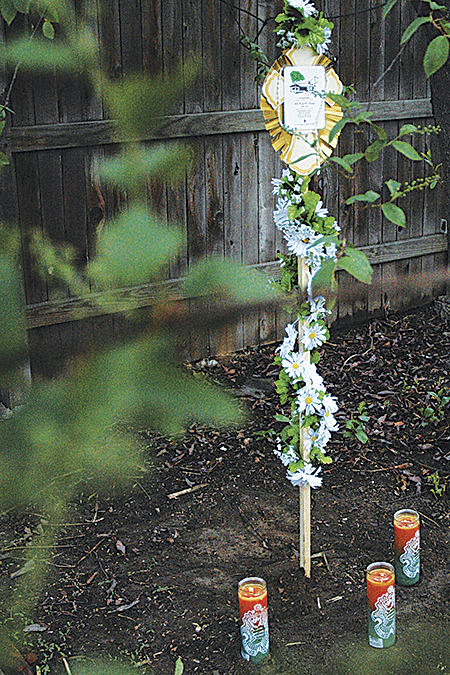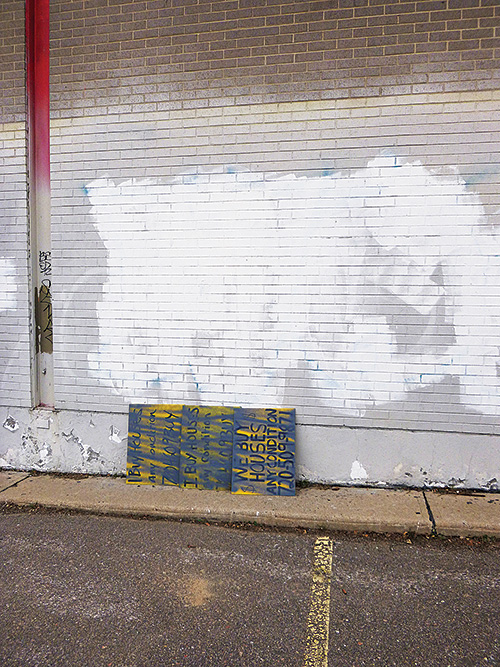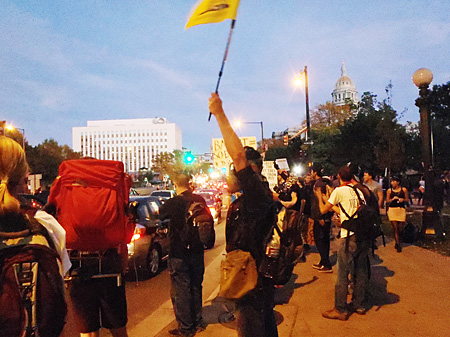Good Neighbor’s Lamentation Society
Wednesday, May 17th, 2017INDIVIDUAL: A good neighbor
GROUP SIZE: Undetermined, possibly in the thousands
NATURE OF GROUP: Long-time residents and homeowners, new residents and home owners, real estate agents, investors, developers, architects, city and urban planners, local government officials, demolition crews, contractors and day laborers, local newspaper journalists, and anti-gentrification activists
INCIDENCE: The Good Neighbor’s Lamentation Society
It broke our hearts to leave you,
But you did not go alone,
For part of us went with you,
The day God called you home
– From the shrine for 3115 West 19th Avenue
3115 West 19th Avenue – on life support
3115 West 19th Avenue – in memoriaum
Dear Friends, we are gathered to celebrate and remember the lives of our good friends and neighbors 1815 Grove Street, 3115 West 19th Avenue, 1925 Hooker Street, 1935 Hooker Street, 1821 Irving Street, and 1828 Julian Street. I came to know these neighbors through frequent walks around our neighborhood as I nodded hello, remarked either to myself or my companion about their appearance or allowed my dog to curiously sniff their landscaping (or lack thereof). Over the years, our relationship never grew close but instead yielded to a comfortable familiarity – like that of a good neighbor.
Over the years, as new residents moved in and old ones moved out, each neighbor stayed true to their humble beginnings. Sure, some may have added a satellite dish, a chain-link fence, a swing set or a stained mattress over the years to enhance their external appearance but as their other neighbors fell prey to the whims of fashion these stalwarts remained true. They may have received a fresh coat of paint from time to time (or not) but they never lost the sense of who they were. Our neighbors were homes where children played, where families laughed, where tuckpointing was neglected, and yard work went undone. And they weren’t just our neighbors but they were also part of the larger Denver community who had largely overlooked our neighborhood until very recently.
First came the “Coming Soon” or “For Sale” signs. Memories of the last recession were still fresh in our community and we blithely laughed at the idea of our neighborhood becoming “an urban oasis right in the center of it all.” Then came the tiny plastic flags and unintelligible spray-painted symbols in front yards. The previous inhabitants would move out yet, strangely, no one else would move in. Next came the plastic orange mesh fences. That is when we knew the situation had become dire. The new owners, investors and developers mostly, did what they could to make our neighbors comfortable. They removed garbage and glass, boarded up windows, and even in some terminal cases excised trees, but at this point we knew our neighbors were just a shell of their former selves. There was nothing more that could be done. It was time to prepare for the end.
Just as we shall never know the hour God will call us home, so it is with Denver demolition crews. Without warning, where once your neighbor stood, a home was now rendered unto dust.
Some feel our neighbors’ lives had been lost too soon and believed that their aging bones and sagging foundations still pulsed with vitality. They could still see their beauty, even in their last years of neglect, when others could not. Their grief was raw but understandable. Some are moved to organize and form movements to prevent future losses. Others accept these losses as merely a part of urban life. Others still just complain. In these varied reactions what is universal is their pain. Together we all grieve. This is why, we, The Good Neighbors Lamentation Society, have chosen to memorialize our neighbors. May our memories give us strength and these shrines bring us peace.
1815 Grove Street – in memoriaum
1821 Irving Street – in memoriaum
Findings and Final Report:
Metro Denver’s population growth has outpaced national growth rates since the 1930s. By 2020, Metro Denver’s population is anticipated to increase from 2.8 million to more than 3.3 million. Large tracts of the city are undergoing wholesale urban renewal, which is especially pronounced on the city’s West Side.
The Good Neighbor’s Lamentation Society performed services for six demolished houses in the gentrifying West Colfax neighborhood. The neighborhood’s rapid change raised many concerns among long-time residents and activists alike. At the core of the controversy is the rezoning and redevelopment of residential lots that result in many older, single-family homes being demolished. Concerned residents and activists argue that this wave of redevelopment has threatened the character of their neighborhoods and erased the history of old Denver. Developers and pro-growth residents argue that the redevelopment has allowed long-time area homeowners to cash out on an inventory of largely unexceptional, 1950s starter homes, many of which were in disrepair. The demolition of these original structures opens up large urban lots perfect for building high-density, multifamily townhomes that cater to the tastes of affluent home buyers who are increasingly flocking to urban areas.
As longtime neighborhood residents, members of The Good Neighbor’s Lamentation Society have mixed feelings watching their neighborhood change so dramatically. While our sympathies lie with displaced residents and we abhor the slapped together, Brutalist box-like architecture of new Denver, the activists who are decrying change often fail to acknowledge how rundown and, dare we say, undesirable the neighborhood has been for years – often due to the neglect of those very same displaced residents and derelict slumlords.
As artists, we have not sought to make a loud political statement but have instead sought to create a quiet and contemplative memorial. The purpose of activism is to get the largest number of people possible behind a unified message. The purpose of art is to elicit an emotional response from a singular viewer that may engender critical thinking and pose questions instead of answering them. While The Good Neighbor’s Lamentation Society was formed to memorialize properties – not proselytize against change – our sincerest hope is that all of our neighbors, new and long-time residents alike, are able to have a safe and affordable place to call home.
And when I go and prepare a place for you
I will come again and will take you to myself,
that where I am you may also be.
John 14:1-3
– From the shrine for 1828 Julian St.
This report was written by Heather Link-Bergman.
All photos by Heather Link-Bergman
—–
A version of this report was featured at is EMANCIPATION, Sociometry Fair 2016, in Los Angeles, California and was originally published in is EMANCIPATION The Institute of Sociometry at 21. This report was also published in Raw Fury #4.









































